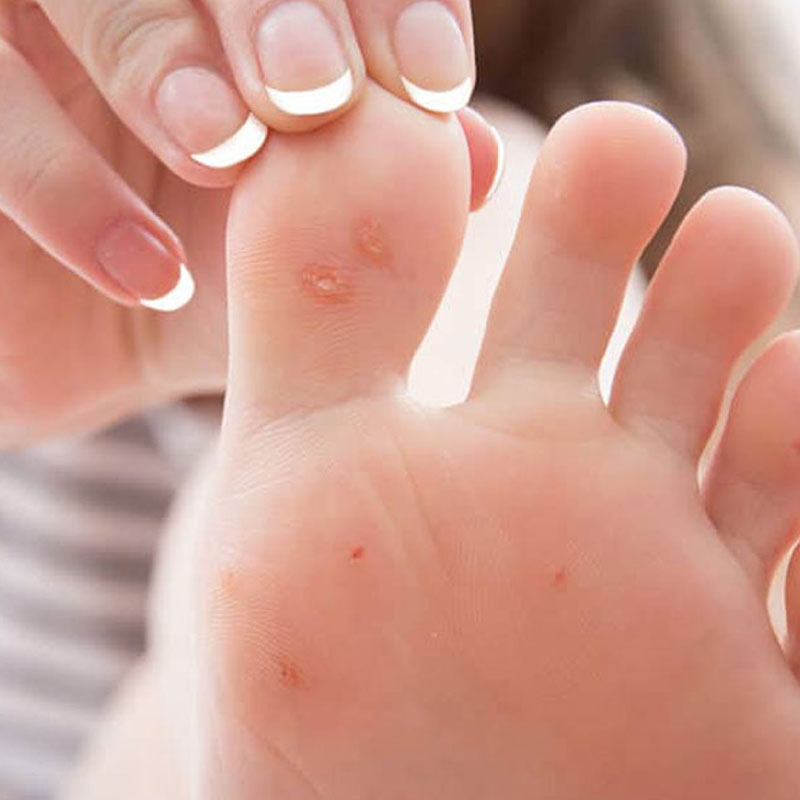WHAT ARE CORNS AND CALLUSES?
Simply put, Corns and Calluses are hard, thickened patches of skin, that can appear on any part of the body, but is usually found on the foot.
Corns are the small, rounded patches of skin, that usually occur on the top and sides of your toes, as well as the soles of your feet. They occur frequently for those with a bonier foot that lacks cushioning. They are usually yellow in colour, and has well-defined edges.
Calluses, on the other hand, are hard and rough patches of skin that occur on the heels or balls of your feet. They can also occur on your hands, knuckles and other areas. They are usually bigger and more yellow that Corns. They also lack the well-defined structure that characterises Corns.
Both Corns and Calluses are usually painless, but could become painful over an extended period of time or if an infection is present.
CAUSES OF CORNS AND CALLUSES
The most common cause of a Corn or Callus is the constant friction and pressure that the foot goes through. It is the body’s way of protecting the skin from developing blisters or any other damage.
Most of the times, this friction and pressure is caused by wearing footwear that is too tight and doesn’t fit well. This is a very common reason behind the formation of Corns and Calluses. However, even if your footwear fits well, walking, running, and even standing a lot can also cause them to form.
For those who wear heels, the immense pressure applied on the balls of your feet can cause Calluses in the region.
Other notable causes for the formation of Corns and Calluses are as follows:
- Going barefoot.
- Wearing socks or shoes that cause bunching of the linings.
- Athletic activities that tend to put immense pressure on the feet.
- Manual labour that causes the exertion of immense pressure on the feet.
Regardless of the cause, the frequency and chances of you getting a Corn or a Callus depends on other factors as well, such as:
- The existence of bunions or hammer toes.
- Walking with an Overpronation (when your ankles roll inwards too much) or Oversupination (when your ankles roll outwards too much).
- Damaged sweat glands, or scars and warts on the foot.
CORNS AND CALLUSES TREATMENT
Usually, Corns and Calluses do not require specialised treatments if it isn’t bothering you. In such cases, you can follow various home remedies to help soothe the affected regions and prevent it from getting worse:
- Corn Plasters: these are thick rubber rings that have an adhesive side. These are pasted onto the affected region so as to alleviate some of the pressure on the site.
- Callus Pads: similar to the corn plasters, these adhesive pads help limit friction and pressure in the callus regions
- Soaks: warm water soaks are a great way to soothe the affected skin. Soaking the feet in warm water for about 20 minutes, followed by gentle scrubbing using your finger or pumice stones can help remove the thick skin. Other beneficial soaks can use tea tree oil, apple cider vinegar, etc.
If home remedies do not work, you can consider consulting a doctor, because the cause of your Corn or Callus could be linked to an underlying condition. For instance, if you have diabetes, your Corns or Calluses may tend to get painful and infected, hence needing medical attention.
Upon consultation, the doctor will closely examine your affected regions and run a few simple tests to understand the severity of the Corn or Callus. Sensitivity of the skin will be tested by pressing gently, and you may even be asked to walk to asses your gait. Once a proper understanding of your condition is determined, a personalised treatment option will be presented to you. In rare instances, you may be recommended a surgical removal of the Corn or Callus, if it is too painful or severely infected. The surgical removal is a painless procedure, and you will be able to walk normally soon after.
PREVENTING CORNS AND CALLUSES
There are several steps you can incorporate into your daily life to prevent the formation of Corns and Calluses. Do note, these are simple preventive measure that lessen the chances of you developing a Corn or Callus, and not a complete fix. The preventive methods are as follows:
- Footwear: Wearing well-fitted socks and shoes can help prevent Corn or Callus formation by an exponential amount. A simple hack to ensure this is to shop for footwear during the afternoon, as it is normally the time when your feet are the widest.
- Foot Care: Follow adequate foot care steps to protect your skin from potential hardening. When you wash your feet, or it comes in contact with water, make sure to dry it well. You can also incorporate the usage of a foot file or pumice stone to scrub the skin, removing any dead cells and soothing the skin. You may also consider using a foot cream that moisturises the skin and nourishes it.
- Proper Medical Care: If you ever experience foot pain of any kind, do not hesitate to reach out to a doctor and get it checked out. This can help you identify the causes of stress and pressure on the foot, and make the necessary changes to prevent them.

